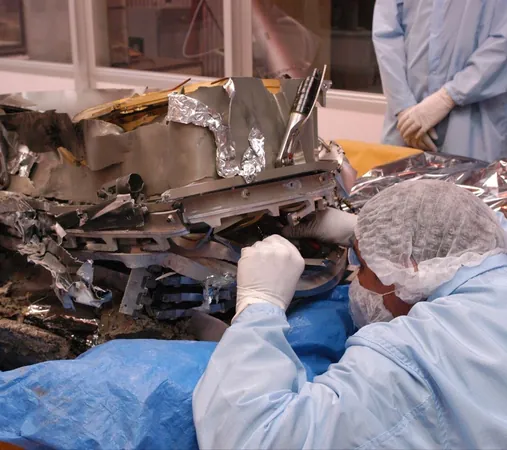
Surprising Scientific Triumph: Genesis Spacecraft’s Secrets Uncovered Two Decades After Crash
2024-12-09
Author: Yan
Introduction
In September 2004, the NASA Genesis spacecraft met a tragic fate when its return capsule crashed in the Utah desert after a parachute failure during landing. This unfortunate event occurred in a desolate area of the U.S. Army's Dugway Proving Ground, where the capsule shattered, and its delicate solar wind collection wafers were irrevocably damaged. Fast forward two decades, and scientists are now reveling in groundbreaking discoveries derived from what initially seemed like a devastating setback.
The Genesis Mission Overview
The Genesis spacecraft was designed to capture samples of solar wind—subatomic particles released by the sun—by positioning itself at Lagrange Point 1, a point in space where gravitational forces between the Earth and the sun are balanced. Despite the $264 million investment by Lockheed Martin and the ambition of its scientific goals, an engineering error linked to misaligned gravity-switch sensors led to the catastrophic crash. Parachutes did not deploy as intended, resulting in a loss that was initially deemed irreparable.
Recovery and New Discoveries
However, through perseverance and innovative research techniques, scientists have begun to extract significant knowledge from the remnants. At an upcoming meeting of the American Geophysical Union (AGU) scheduled for December 9-13 in Washington, D.C., researchers are gearing up to unveil compelling advancements informed by the contaminated pieces of Genesis.
Dr. Amy Jurewicz, a project scientist at NASA’s Jet Propulsion Laboratory and an assistant research professor at Arizona State University's Center for Meteorite Studies, articulated the excitement permeating her team. "We are finally getting to the point where we can conduct truly intriguing science," she remarked. What once seemed like a disaster has turned into a treasure trove of scientific inquiry.
Challenges and Innovations
The initial challenge was navigating the dirty fragments of solar wind collectors. Jurewicz noted that the meticulous cleaning and study of these tiny samples have resulted in revelations about the nature and implications of solar wind. In total, researchers estimate they have between 5,000 to 10,000 fragments available for scientific scrutiny, made possible by the dedication of specialists lending their expertise to this unique scientific endeavor.
One notable innovation is the comparison of Genesis findings with data gathered from NASA's Advanced Composition Explorer (ACE), which continuously observes solar phenomena since its launch in 1997. This cross-reference allows for a more comprehensive understanding of solar events and their terrestrial effects.
The Impact of the Findings
Not all collectors were damaged equally. The intricate design of the collector materials, intended to capture different solar wind regimes, offers researchers the ability to identify specific fragments by measuring their thickness—a sophisticated technique that has provided unexpected opportunities for analysis.
Despite the initial disappointment surrounding the crash, Genesis has delivered a wealth of data that may challenge existing scientific models, especially concerning the isotopic and chemical composition of materials in the solar system. Kevin McKeegan from UCLA highlighted that prior understandings are now in question, leading to a new phase of research regarding solar wind and how it affects celestial bodies like the Moon and asteroids.
Conclusion
In essence, Genesis is not just a story of loss but a narrative of perseverance and discovery. The mission remains pivotal in the history of robotic exploration as the first to return samples from beyond the moon's orbit, and its contributions to our understanding of cosmochemistry are still being actively utilized by researchers.
In this age of ongoing innovations, the Genesis mission serves as a reminder that sometimes failures can open doors to extraordinary scientific breakthroughs. Who would have thought that two decades after a brutal crash, we’d still be learning so much more about our solar system? Stay tuned for more revelations as the research community continues to uncover the rich secrets hidden within the shards of the Genesis spacecraft!




 Brasil (PT)
Brasil (PT)
 Canada (EN)
Canada (EN)
 Chile (ES)
Chile (ES)
 España (ES)
España (ES)
 France (FR)
France (FR)
 Hong Kong (EN)
Hong Kong (EN)
 Italia (IT)
Italia (IT)
 日本 (JA)
日本 (JA)
 Magyarország (HU)
Magyarország (HU)
 Norge (NO)
Norge (NO)
 Polska (PL)
Polska (PL)
 Schweiz (DE)
Schweiz (DE)
 Singapore (EN)
Singapore (EN)
 Sverige (SV)
Sverige (SV)
 Suomi (FI)
Suomi (FI)
 Türkiye (TR)
Türkiye (TR)